During his lengthy tenure in charge of Aberdeen, Derek McInnes oversaw a period of relative consistency, with The Dons never finishing below fourth in any of his eight full seasons as manager. The club has failed to maintain that level following McInnes’ departure at the end of the 2020/21 season, dropping to ninth in 2021/22, recovering to third in 2022/23 and again competing in the bottom half of the table at present in the 2023/24 campaign.
Since taking charge of Kilmarnock, McInnes helped the club secure promotion back to the top flight in 2021/22, survive in their first season back in the big time last term and taken them forward in 2023/24, with Killie currently sitting fourth in the Scottish Premiership despite competing with a wage bill less than that of Aberdeen and Hibernian (according to Capology), both of whom currently sit below McInnes’ side on the Premiership table and the second-least valuable squad in Scotland’s top flight according to Transfermarkt. Killie are also playing with the third-youngest squad (25.9) in the Scottish Premiership this season, per Wyscout.
None of these metrics are the be-all and end-all — there’s plenty more than just those that go into determining a squad’s quality. However, it does seem fair to say, with Killie just in their second season back in the top flight after their 2020/21 relegation, that McInnes is faring quite well in his current role, producing results that will be keeping all involved with his club quite satisfied at present.
Kilmarnock’s defence has been fairly solid this term, with their 26 goals conceded being the fourth-fewest in Scotland’s top flight at the time of writing while they’ve got the third-lowest xGA (29.47), behind just Celtic and Rangers. They’ve done well to limit the amount of clear-cut chances opponents significantly have been able to create against them with some solid defensive work and organisation.
McInnes’ side has also produced some solid displays going forward this term, which will be the primary focus of this tactical analysis and team-focused scout report. While their numbers alone (joint-sixth-most goals scored with 27 and fifth-highest xG with 33.97) are impressive but not quite as standout as the aforementioned defensive statistics, it’s the way in which they’ve been consistently opening up defences, in particular through the use of the wide channels, their inverted wingers and specific patterns of play that have inspired us to go into detail in this analysis piece.
Therefore, our analysis will highlight some critical aspects of Kilmarnock’s offensive tactics, their intelligent use of inverted wingers and how the consistently effective application of some attacking fundamentals has made them very difficult to defend against for all opponents throughout the 2023/24 campaign.
Wing play chance creation
The wings have been vital for Killie’s chance creation in 2023/24, with left-footed right-winger/right wing-back Danny Armstrong and right-footed left-winger/left wing-back Matty Kennedy proving to be their most fruitful providers.
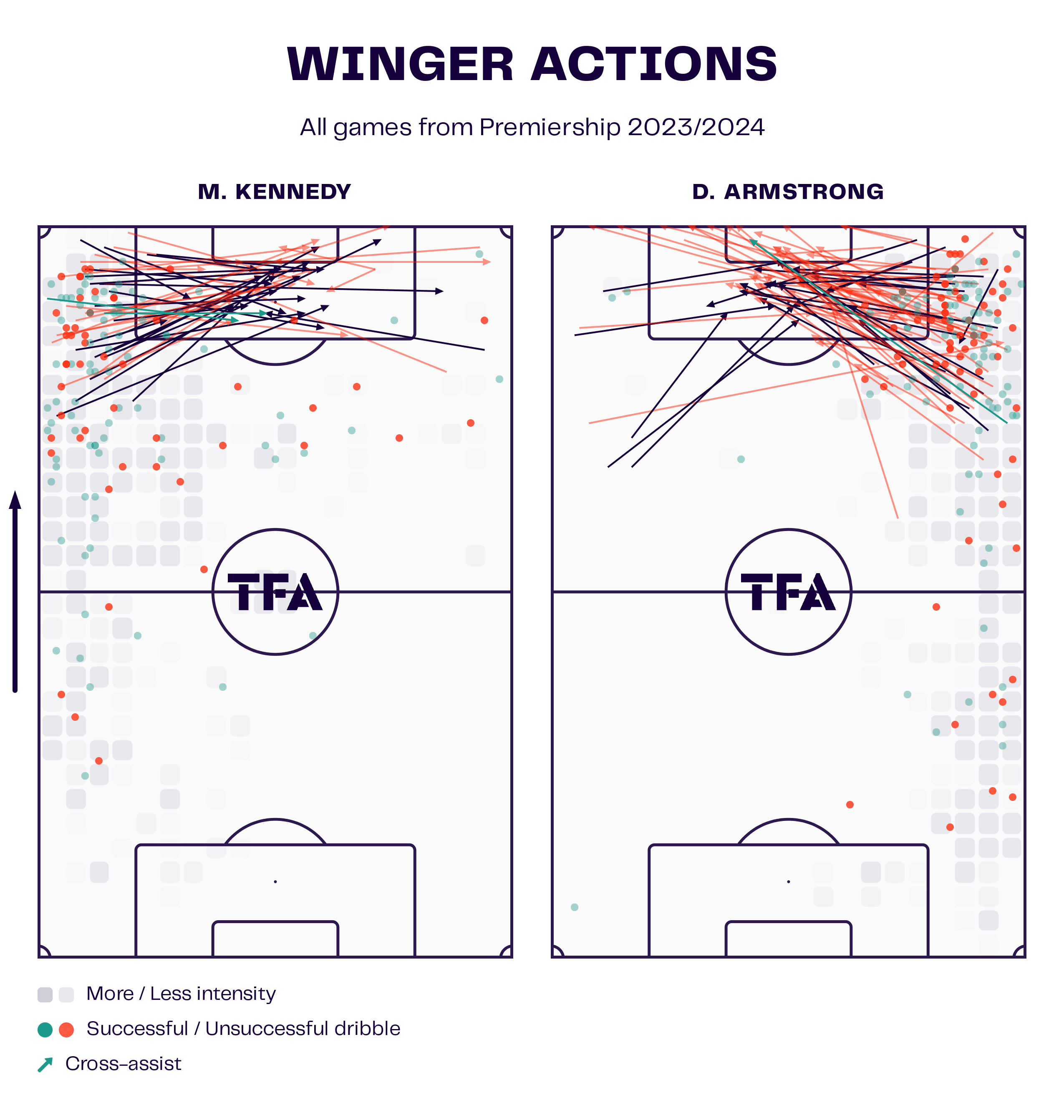
As displayed by figure 1, both players have been fairly high-volume crossers this term, though that especially rings true for right-sided Armstrong.
The majority of both players’ crosses have come from deep rather than more advanced positions. Kennedy is the more likely of the two to advance higher and look to drill a low ball into the box, but again, both are more likely to swing one in early from a bit deeper.
Killie have played the fourth-most crosses in Scotland’s top flight this term (15.86 per 90), which goes some way to highlighting how vital this avenue of chance creation has been for them. They’ve also generated the fourth-most shots in their division (10.45 per 90), which is essentially a result of how effective their crossing and overall wide chance creation has been, with Armstrong, in particular, putting up highly impressive numbers (seven assists, 8.71 expected assists — both the highest in the league).
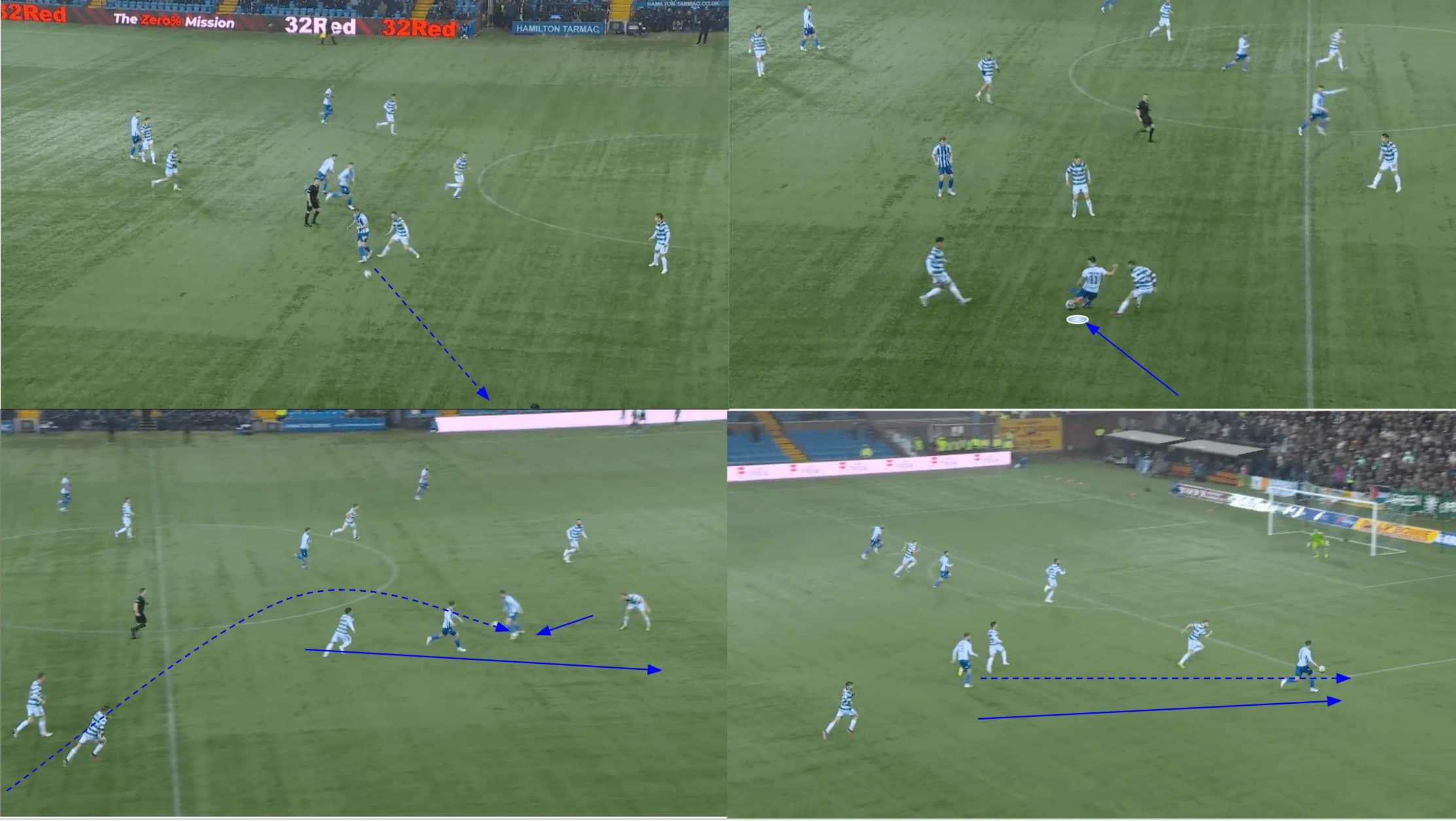
Celtic suffered big time against Armstrong in their latest meeting with Kilmarnock back in December.
Killie’s first goal came as they transitioned to attack, finding Armstrong dropping deep on the wing as the wide man came inside, pulling the ball onto his stronger left foot and finding a target on the edge of the final third.
As the receiver turned, he quickly found an opportunity to play the ball through to a central midfielder, driving forward who could play a cross into the box that was turned into the Celtic net by their own centre-back, Nat Phillips, on loan from Liverpool.
As well as opening up space for the central midfielder to enter out wide via his early movement, Armstrong dragged a Celtic full-back high, ensuring the midfielder moving out wide would have lots of time and space to create once he received in the final third.
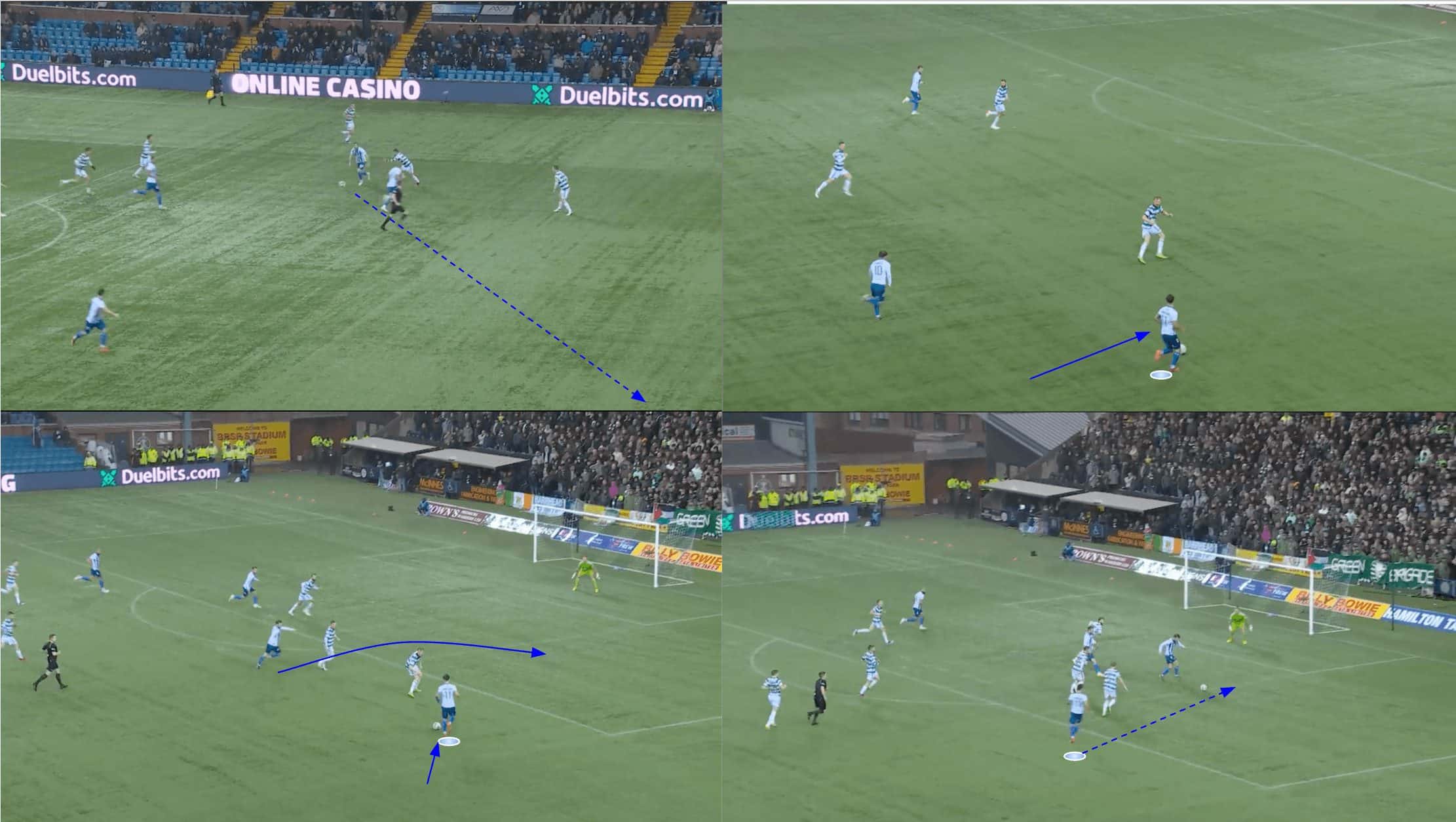
After Phillips’ own goal pulled things back to 1-1, Killie went on to claim the victory, with Armstrong playing a central role once again.
On this occasion, Kilmarnock’s counter entered the final third via the right-winger who received at around the halfway line.
As the left-footed winger entered the final third, Celtic’s full-back guarded against the possible cut inside with his body positioning, as we see in the bottom-left image. However, an intelligent run in behind that defender and through to the opposite side, which was left open, allowed Armstrong to combine with a teammate and advance his side into a very nice goalscoring position, which they took advantage of to go a goal up late on.
The way in which Armstrong waited for this moment before acting too early and losing the ball, the way in which the attacker knew to make this run and get in behind the defence — everything about this move highlights how much chemistry exists within Kilmarnock’s final third play, and this is a credit to McInnes and how he’s moulded this attacking unit into a dangerous weapon.
Wingers’ deep positioning and overlaps
The way in which Armstrong dropped deep in figure 2 was not a one-off incident; as we’ve established, it’s a recurring theme within McInnes’ Killie side with regard to the behaviour of the wide men.
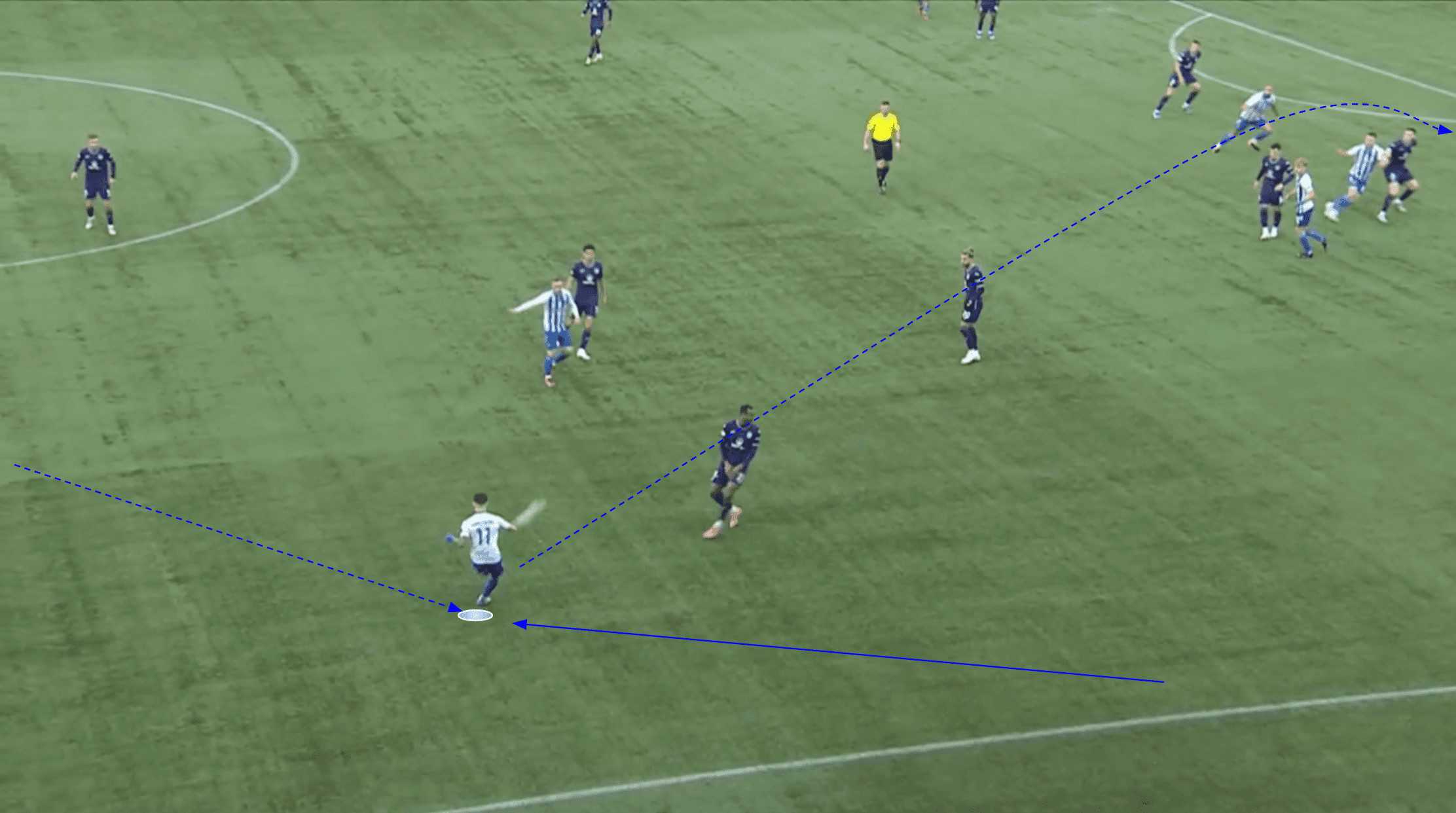
Armstrong, in particular, has been highly effective as something of a wide deep-lying playmaker this term, not even just dropping to play crosses or open space up high as we saw in figure 2, but even dropping and getting his head up to play a ball in behind, as we see above.
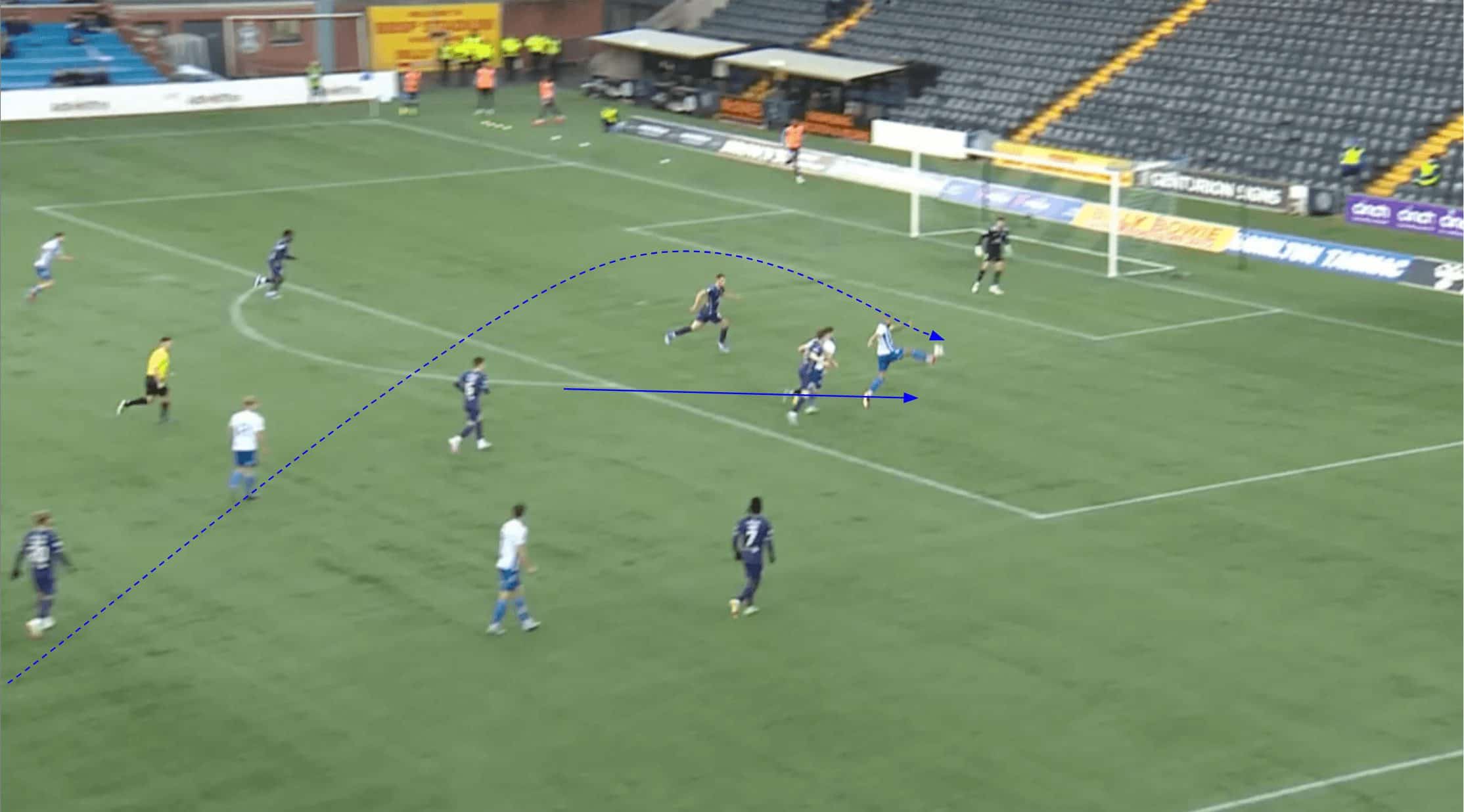
On this occasion, Kyle Vassell met the wide man’s pass, once again demonstrating the cohesion and chemistry within this team’s chance creation play. Vassell made his run knowing what Armstrong likes to do and is able to do from those deep wide positions. Although the pass came quick and early, the striker was moving into the perfect position to meet it, which successfully caught the opponents out and made life difficult for them.
These types of lofted over-the-top through balls are a beautiful part of Armstrong’s game and a real asset for Killie’s attacking play.
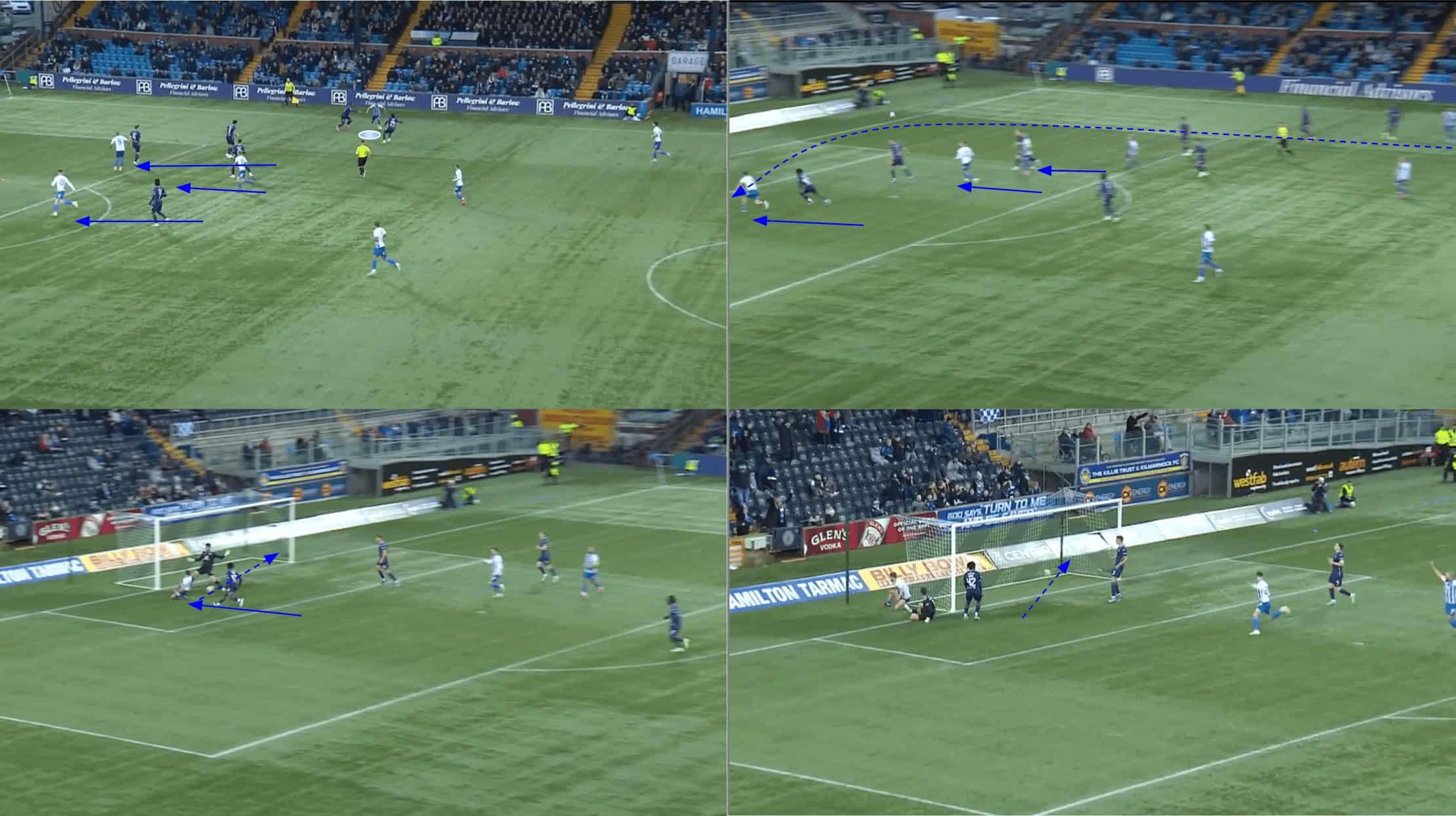
Of course, as mentioned, deep crossing has been ubiquitous for McInnes’ side this term — take figure 6 as an example.
The ball comes in early, but the run is also made early from the striker. Because the ball is played early from deep, there’s space behind the opposition’s backline to run into, which is where the back-post runner can meet the ball and turn it into goal, demonstrating cohesion, chemistry, understanding and a lot of technical quality in McInnes’ side’s chance creation play.
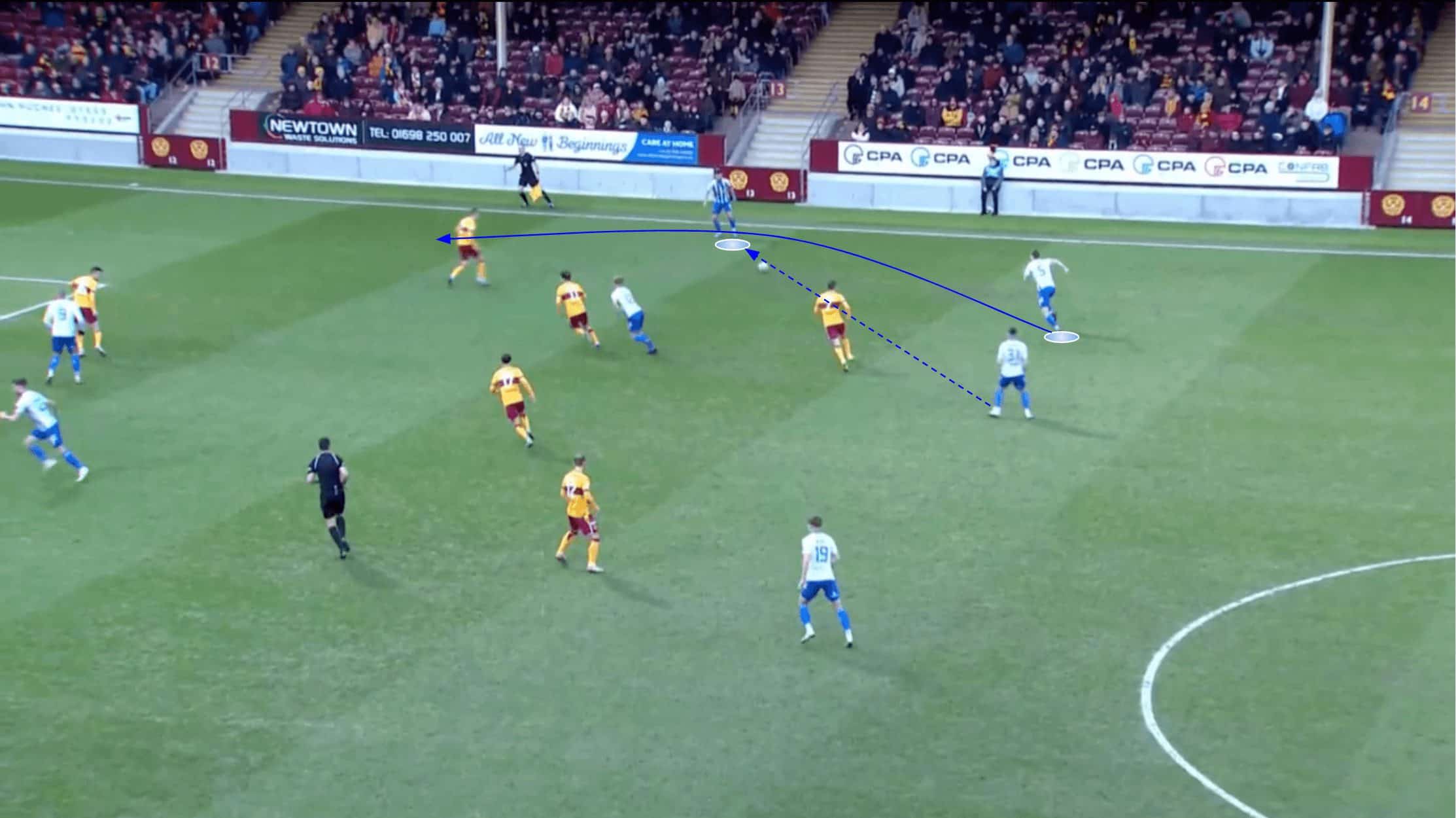
Both Armstrong and left-sided Kennedy like to play deeper; I wouldn’t typically expect to see them sitting on the shoulders of the last defenders at any time — or, at least, it’ll be rarely. Still, McInnes wants someone providing a threat on that last line in the wide channel to take advantage of the potential high positioning of the opposition’s full-back as a result of their winger’s deep positioning and to stretch the opposition’s backline, creating more space for the central attackers to take advantage of their team’s cross.
This is where overlaps come into play — another common part of Killie’s chance creation play.
These are commonly performed by the full-backs in the 4-4-2 Killie have often used or even the centre-backs should they play with a three-centre-back shape — again, as they’ve often done.
In this case, against Kilmarnock, Lewis Mayo was deployed as a right-back, and he immediately began looking to exploit the space behind the opposition’s advancing left-back as Armstrong received.
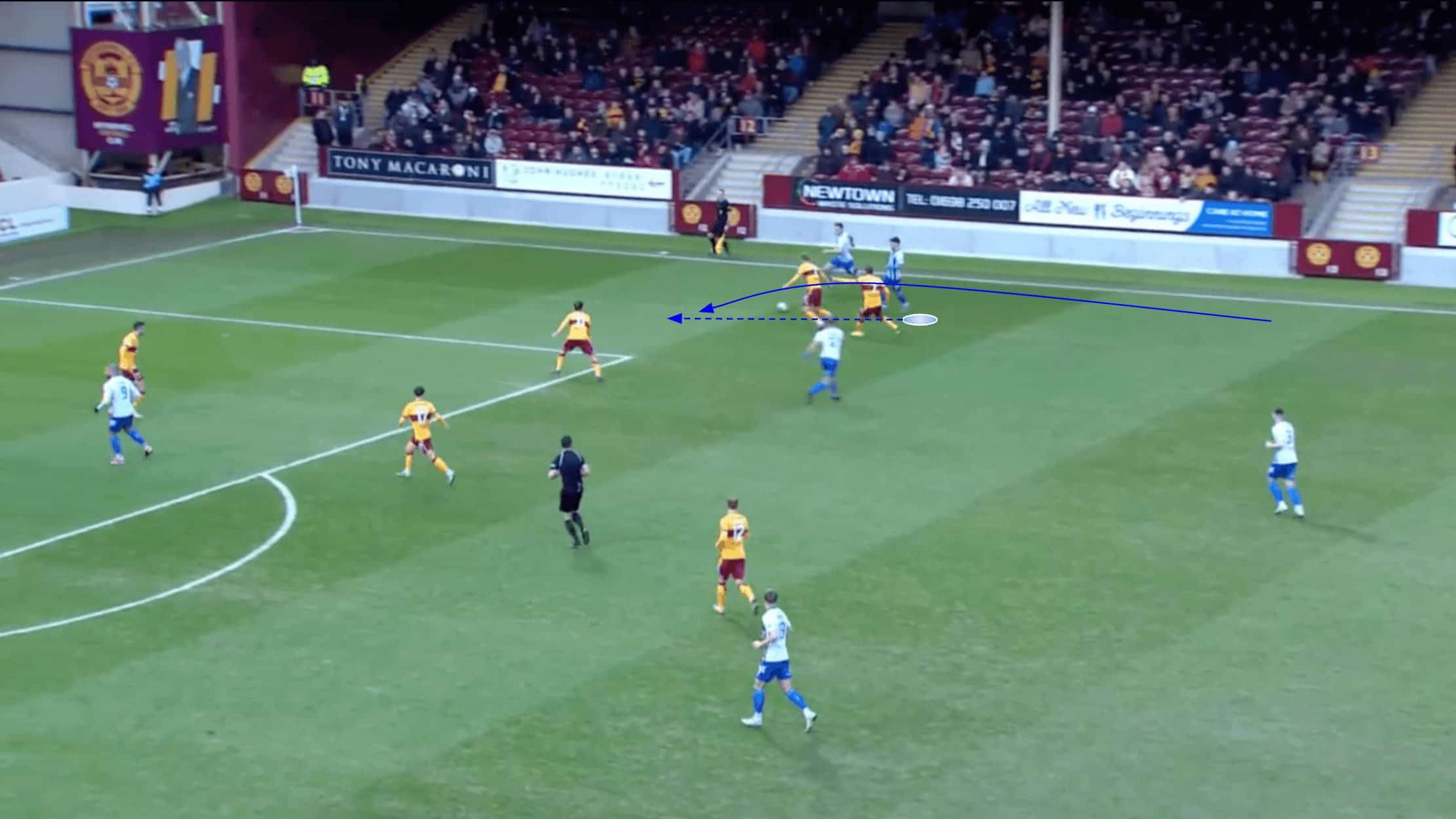
The result is a through pass from Armstrong to Mayo, who now has space to run into behind the opposition’s backline on the wing. From here, we see the full-back drive the ball into the box, demonstrating how this can be another effective tool in Killie’s chance creation arsenal.
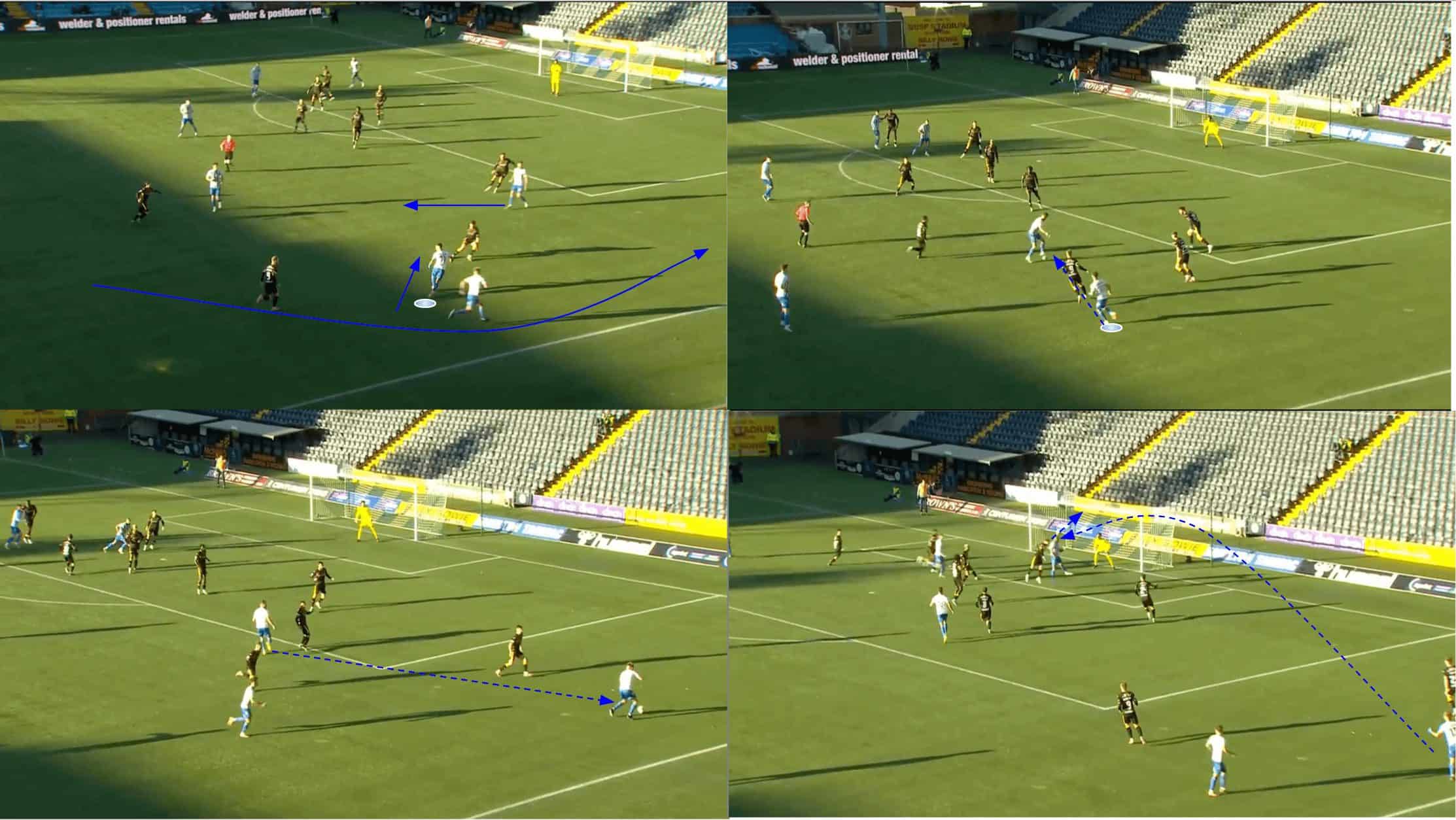
It’s not just defenders who’ve been overlapping like this. However, we’ve also seen midfielders making these runs in the final third — take David Watson in figure 9, for instance.
As Armstrong played the ball inside, Watson had already made an overlapping run to occupy the wide channel on the opposition defence’s shoulder.
The 18-year-old midfielder isn’t picked up by the opposition, allowing him to put a ball directly onto Vassell’s head, with the striker nodding it home.
Vassell has been on the end of a lot of crosses like this in 2023/24, and his aerial quality has had to be good, along with his movement, positioning and first-time finishing ability — all critical qualities for the centre-forward in this setup.

While David Watson has primarily occupied central positions, notably the right central midfield position within his side’s setup, he’s been very active out wide when it comes to chance creation — compare his heatmap above with the shot assist map below.
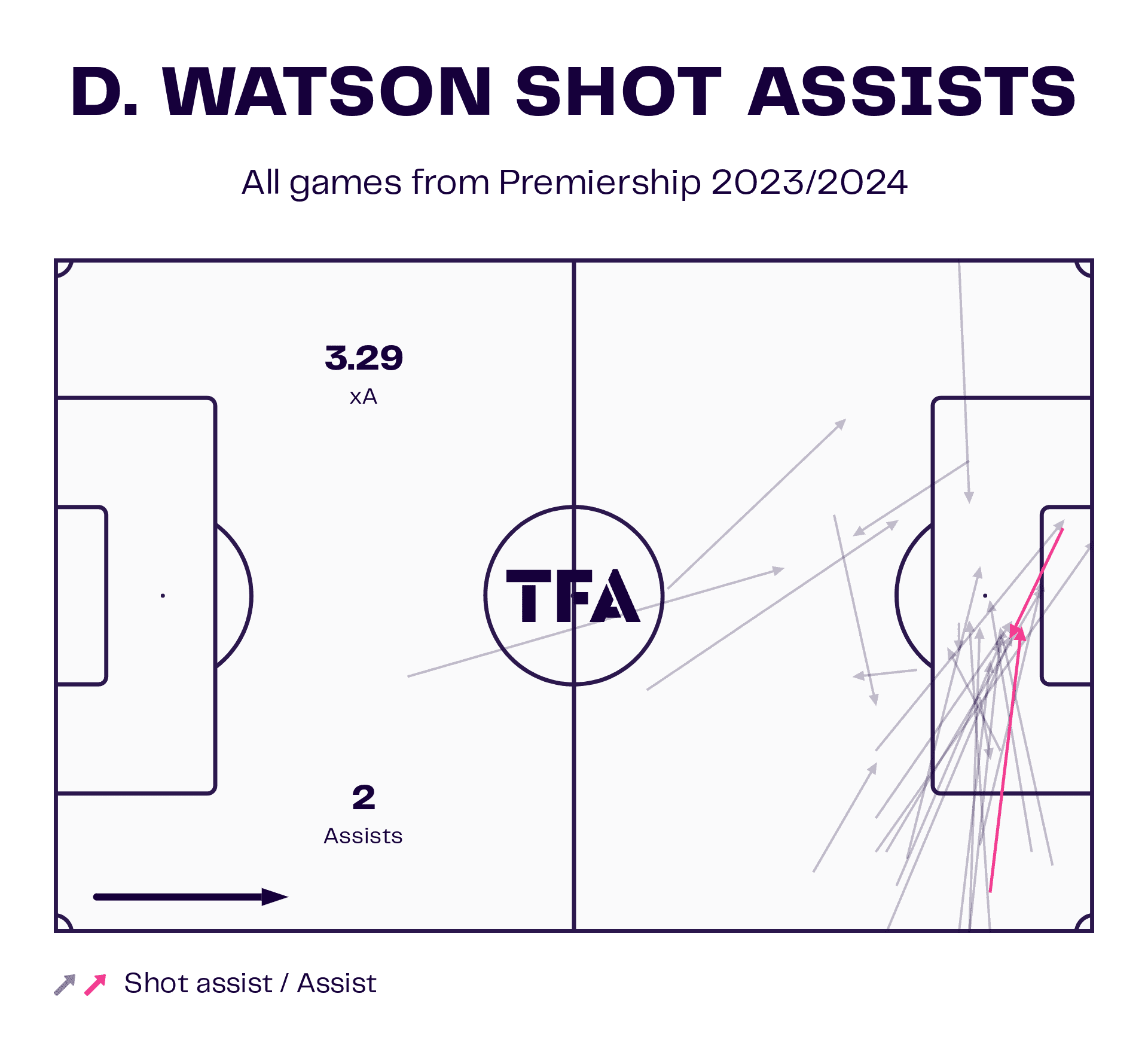
His primary method of chance creation has been crossing, which is a result of his contribution on the overlap and how he’s combined with Armstrong’s movement into central areas.
Bodies in the box and sustaining pressure
Our third and final section of analysis will focus on other attackers’ movement and contribution to ensuring as many Killie crosses end with a positive result as possible.
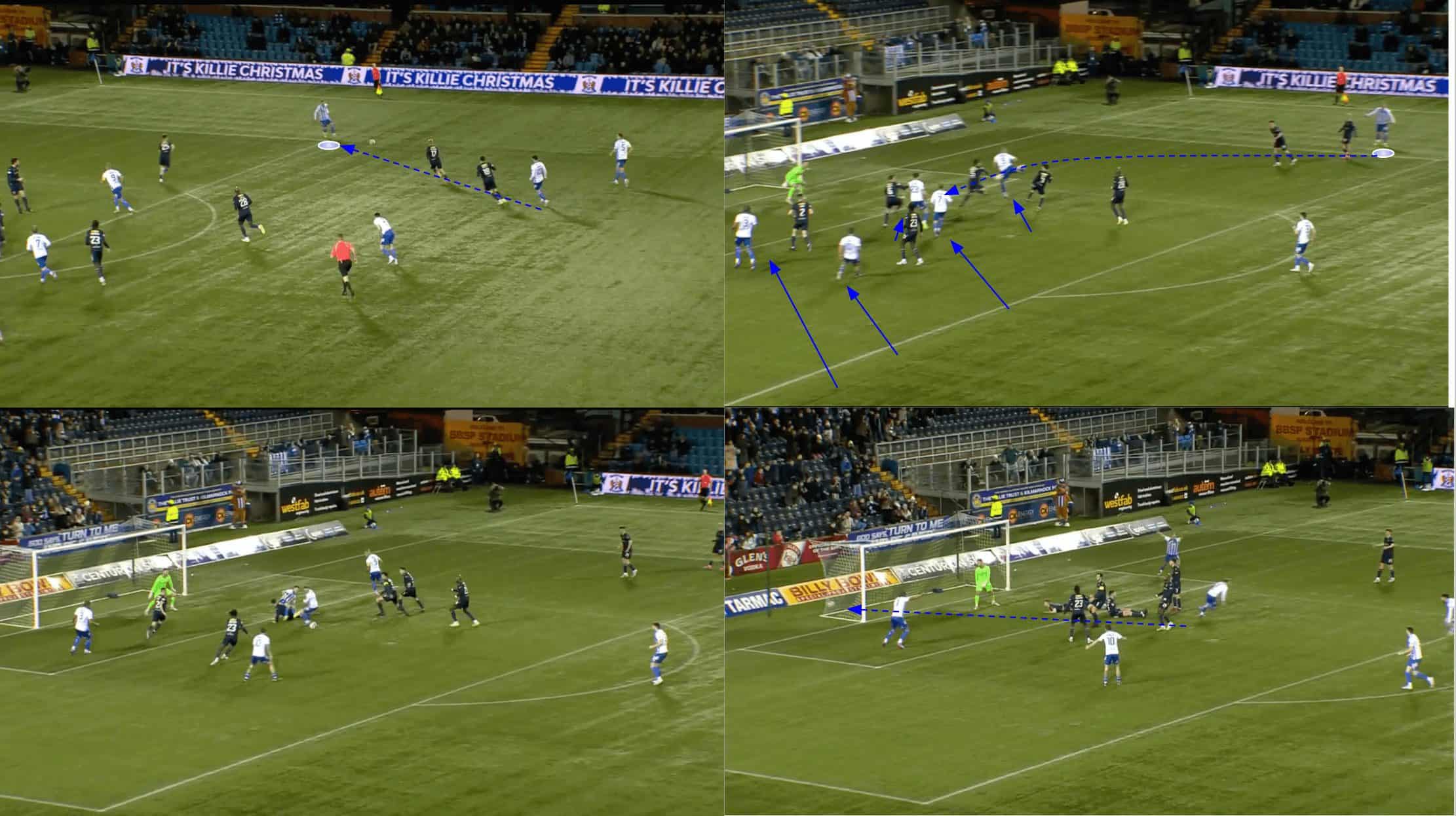
Firstly, if we take a look at figure 12, we see Armstrong receiving out wide again, but it’s also worth noting how he has five Kilmarnock shirts to aim for inside the box and although the initial cross isn’t met with the finishing touch, meaning he doesn’t get a direct assist for this goal, there are enough teammates positioned close by that they can pounce on the loose ball inside the box and send it home.
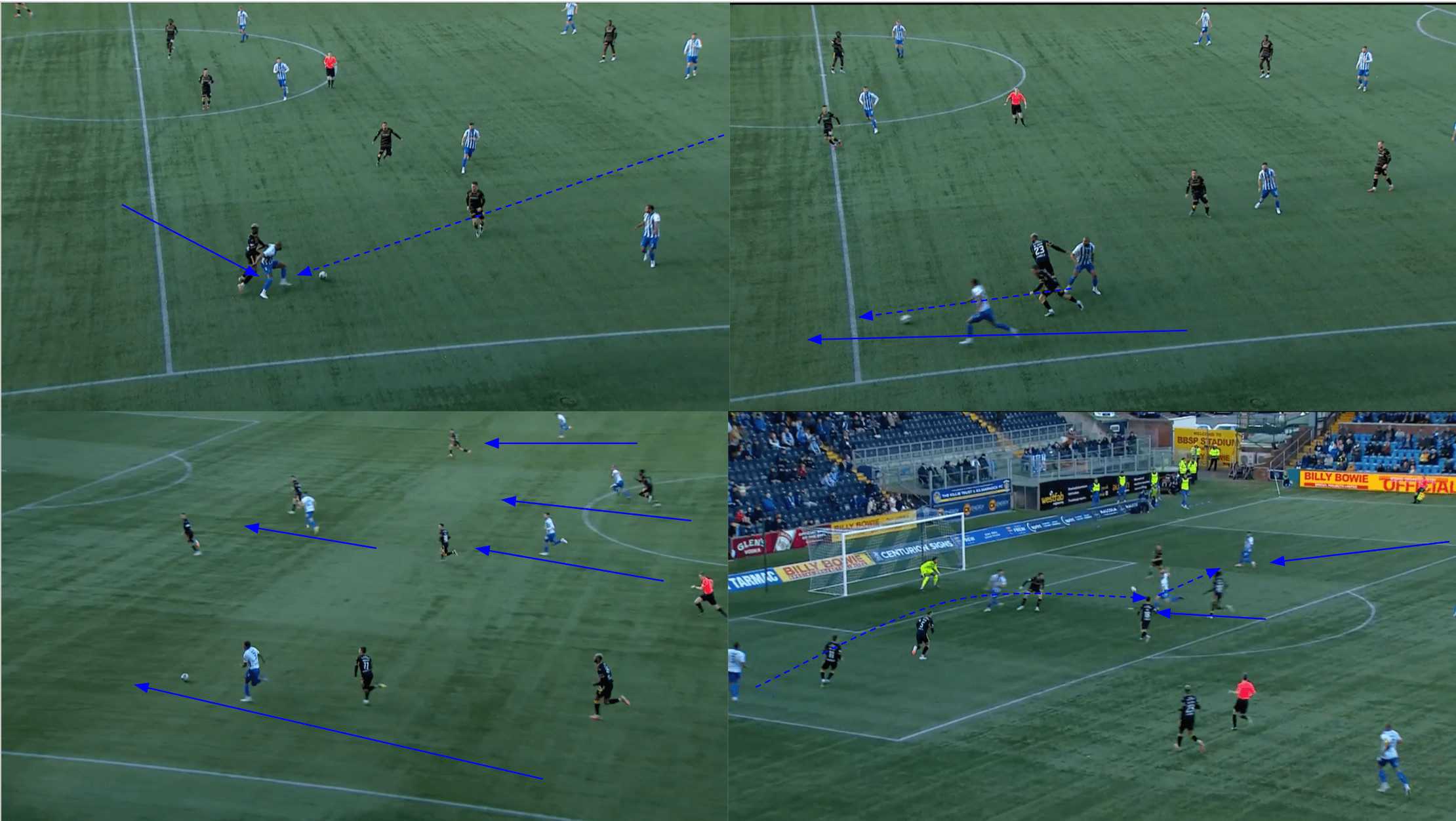
A counterattack in figure 13 sees Vassell dropping off to hold up the ball while left-back Corrie Ndaba overlaps.
As Ndaba is played through, we see the immediate reaction from Vassell’s centre-forward partner, the two midfielders and the ball-far winger, as all start busting a gut to get into the box to provide the ball carrier with options.
The result is that while Nduba’s initial target miskicks, the ball still finds its way through to a Kilmarnock shirt — the ball-far winger, who can get a better shot off at goal.
To summarise, we can expect a minimum of three bodies in the box at any time, even on the counter when everyone has just been back defending when Kilmarnock go to cross. They’re excellent at flooding the box with numbers and ensuring they have players around to react and pounce on loose balls to give their crosses a better chance of being converted; even if the initial attempt after the cross is unsuccessful, they can convert the opportunity.
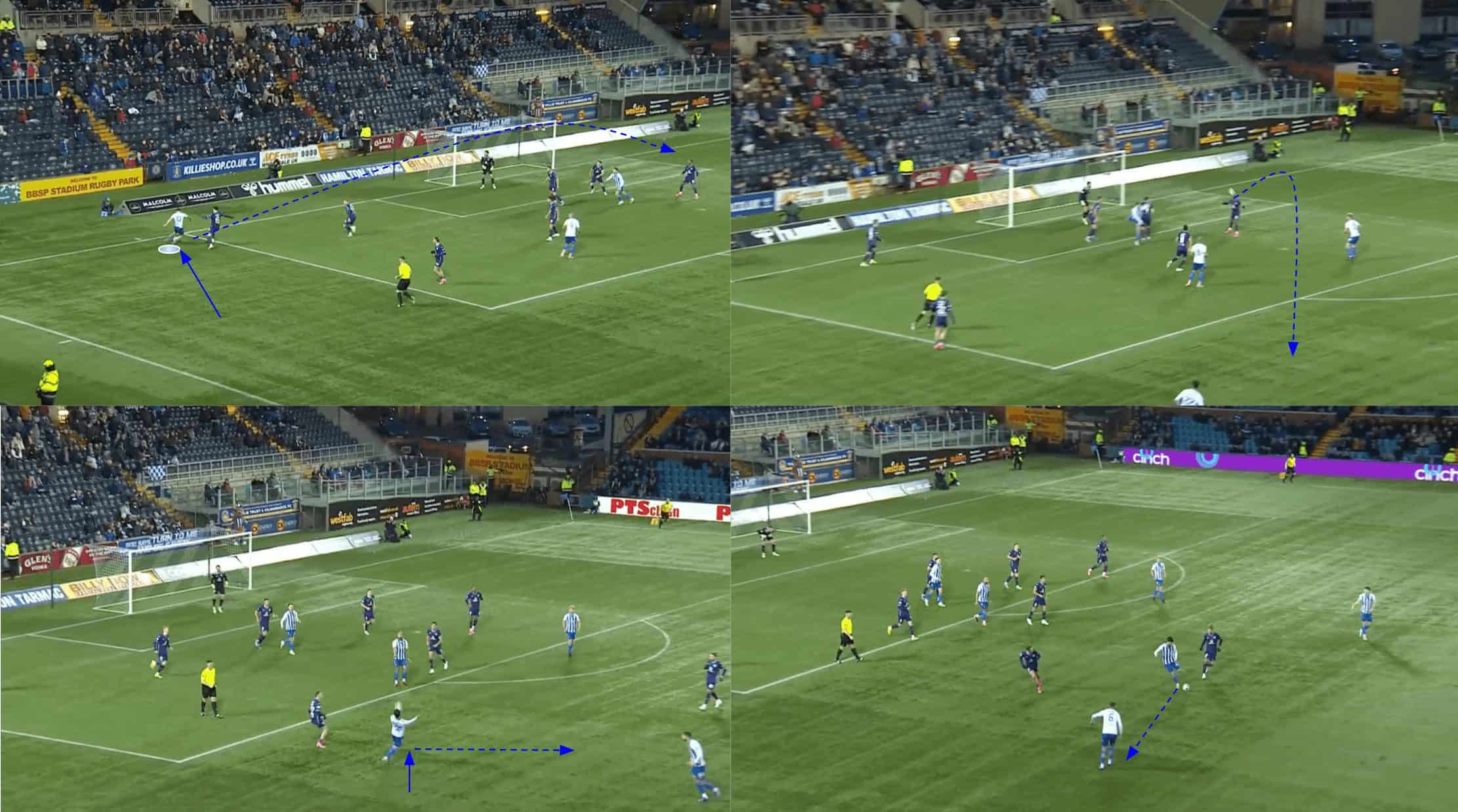
In a similar vein, connected with energy and positioning, expect to see at least one midfielder, usually two, positioned just on the edge of the box to sweep up loose clearances and ensure Killie can sustain pressure if the cross is batted away by an opposition defender as we see in figure 14.
Their organisation, positioning and consistent effort to ensure these kinds of clearances don’t get beyond this third of the pitch have played an important role in helping Killie create opportunity after opportunity and keep the opponent on the back foot, as well as shutting down counterattack opportunities going the other way.
Conclusion
To conclude this tactical analysis and team-focused scout report, players like Danny Armstrong, Matty Kennedy, David Watson and Kyle Vassell have all been key parts of Killie’s chance creation this term, which has centred on wing play.
Along with each individual’s respective quality, factors like the wingers’ deep positioning, effective overlaps, high energy in possession when it comes to runs and off-the-ball movement, as well as high energy out of possession when it comes to pressing the second ball and sustaining pressure have all been vital to making McInnes’ side a threat going forward, something they’ve undoubtedly been throughout the 2023/24 campaign.





Comments